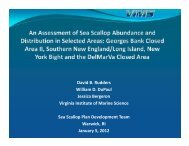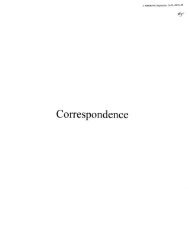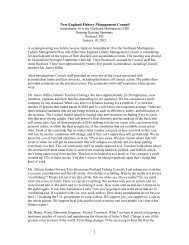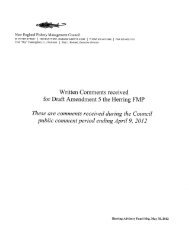Smooth Bottom Net Trawl Fishing Gear Effect on - New England ...
Smooth Bottom Net Trawl Fishing Gear Effect on - New England ...
Smooth Bottom Net Trawl Fishing Gear Effect on - New England ...
Create successful ePaper yourself
Turn your PDF publications into a flip-book with our unique Google optimized e-Paper software.
4.0 CONCLUSIONS AND RECOMMENDATIONS FOR FUTURE STUDIES<br />
4.1 Disturbance and Ecological Structure<br />
The Massachusetts Bay trawling impact study has addressed the impacts of trawling <strong>on</strong> physical<br />
attributes of the seabed and <strong>on</strong> diversity, abundance, and successi<strong>on</strong>al status of the benthos.<br />
Results of our studies in 2001 and 2002 indicate that impacts of net sweep and the ground cables<br />
are not great relative to untrawled reference areas. Local impact of trawl door furrows remains<br />
moot as the REMOTS® survey apparently did not sample these features. Faunal data also<br />
indicate that there were no great differences between trawled and “c<strong>on</strong>trol” (reference) areas in<br />
terms of physical or ecological structure of the seabed. The ambient benthic infauna is adapted<br />
to natural disturbance in the form of bed-load transport of sand and the resuspensi<strong>on</strong> of fines by<br />
tidal turbulence. It is likely that the impacts of trawling <strong>on</strong> the infaunal benthic communities at<br />
Mud Hole and Little Tow are comparable in magnitude to these natural disturbances. This<br />
asserti<strong>on</strong> may not hold true for trawl door furrows as these features, although a small proporti<strong>on</strong><br />
of the impacted bottom, were not adequately sampled.<br />
4.2 Disturbance and Ecological Dynamics<br />
The 2001 and 2002 trawling studies have focused <strong>on</strong> seafloor bathymetry, sedimentary<br />
structures, benthic invertebrate and fish inventories, and fish stomach c<strong>on</strong>tents. Rate dependent<br />
processes were not addressed. Any deeper understanding of the effects of trawling will require<br />
informati<strong>on</strong> about these rate sensitive processes. For example:<br />
1.) What are the rates of infaunal recovery (rate of arrival of col<strong>on</strong>izing individuals and species<br />
per unit time) in disturbed bottom areas affected by both natural and trawling disturbances?<br />
2.) How do these disturbances impact sec<strong>on</strong>dary productivity of the bottom (change in prey<br />
biomass per unit area per unit time)?<br />
If these two questi<strong>on</strong>s can be answered, <strong>on</strong>e may be able to determine (in advance) the upper rate<br />
of trawling that a site can sustain without compromising bottom sec<strong>on</strong>dary productivity.<br />
The ecological impact of trawling <strong>on</strong> the benthic infauna, as described in our Massachusetts Bay<br />
study and those cited from Swedish waters (Nilss<strong>on</strong> and Rosenberg, 2003) and the<br />
Mediterranean (Rosenberg, et al., 2003 and Smith, et al., 2003), indicate that disturbance by<br />
trawling does not cause total mortality of the impacted areas. Rather, near surface-dwelling<br />
organisms tend to be more severely impacted than deeper-living species. By definiti<strong>on</strong>, faunal<br />
recovery therefore takes place as a sec<strong>on</strong>dary successi<strong>on</strong> (primary successi<strong>on</strong> involves<br />
repopulati<strong>on</strong> of a substratum representing competiti<strong>on</strong>-free space).<br />
The rate and mode of recol<strong>on</strong>izati<strong>on</strong> and successi<strong>on</strong> is scale-dependent and also is affected by<br />
the kinetic energy of the ambient bottom (McCall, 1977 and Whitlach, Lohrer, and Thrush,<br />
2003). Small-scale disturbances such as anchor scars, trawl door furrows, predator foraging pits,<br />
etc., can be very rapidly recol<strong>on</strong>ized <strong>on</strong> a scale of hours to days by immigrati<strong>on</strong> of juvenile/adult<br />
organisms from the adjacent ambient bottom (i.e. n<strong>on</strong>-larval recruitment). This is especially<br />
62







